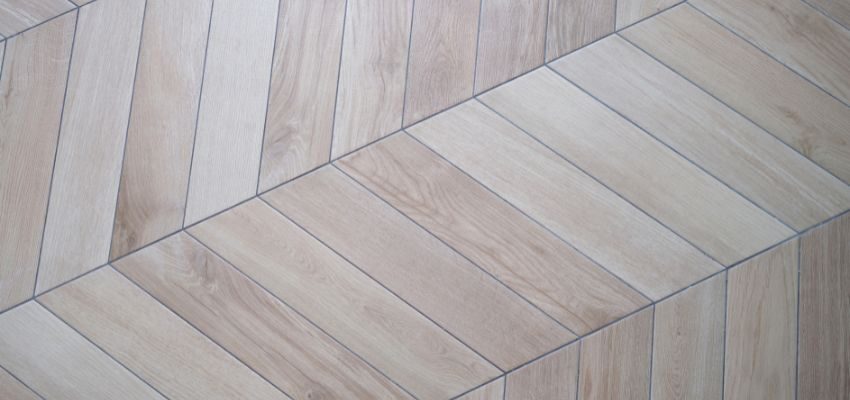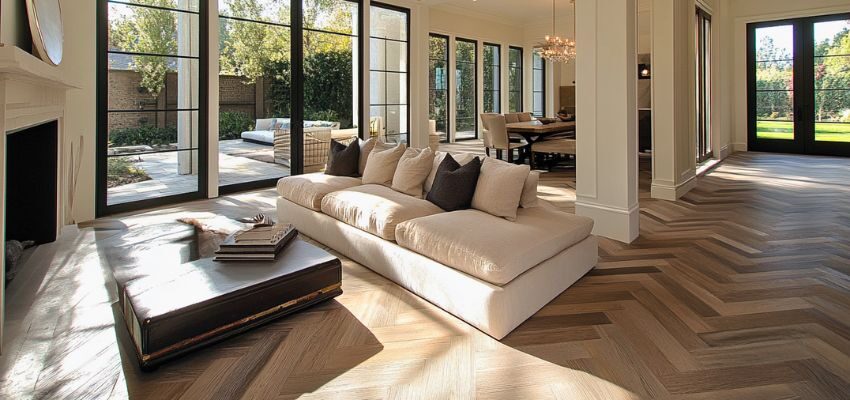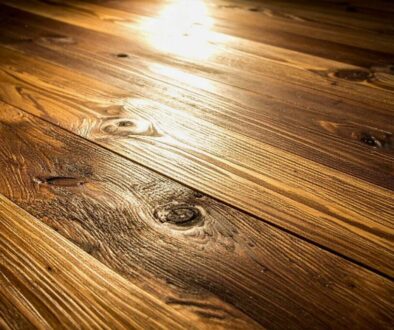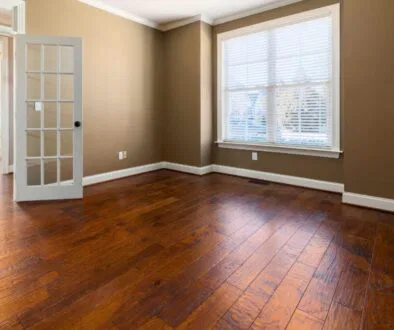Distinguishing Chevron Vs. Herringbone Flooring: An Overview

Published November 20, 2024
Selecting the perfect flooring can significantly impact your interior design. As a crucial element that defines the tone and elevates a space’s aesthetic, it’s vital to make the right choice. Have you ever thought about the timeless allure of herringbone and chevron patterns? These coveted designs have graced homes, palaces, and historic buildings for centuries.
In this article, we’ll focus on the debate between chevron vs herringbone. We’ll explore their history, construction, benefits, and installation, offering valuable insights to guide you in selecting the ideal style for your home.
History Of Herringbone And Chevron Floors
Both the herringbone and chevron patterns have long histories.
The herringbone pattern traces its origins back to ancient civilizations. It was named for the skeletal structure of the herring fish. The pattern was used in road construction during the Roman Empire and in textiles and jewelry across Italy and Egypt. It was later introduced to wood flooring in France as early as the 16th century, notably at the Château de Fontainebleau.
The chevron pattern also has a rich history. It appears in ancient Greek pottery and medieval heraldry, and its use in flooring dates back to 16th-century Europe.
Chevron Vs Herringbone: How Are These Patterns Created?
While the patterns in chevron vs herringbone are strikingly similar, there are variations in how they are made. The creation of these patterns involves precise cuts and placements of wooden planks.
Herringbone utilizes rectangular planks laid at right angles to each other, forming a broken zigzag pattern. This arrangement creates a sense of movement and can visually expand a space.
In contrast, the chevron pattern is crafted by cutting the ends of planks at an angle, allowing them to meet in a pointed, continuous V shape. This configuration is dynamic and conveys a contemporary aesthetic.

Distinguishing Chevron Vs Herringbone Patterns
Though similar, these patterns can be distinguished by their alignment and angles. Herringbone floors consist of rectangular planks arranged in an interlocking zigzag pattern. The planks meet at 90-degree angles.
Planks are cut at specific angles in a chevron design to form a distinctive pattern. The ends of the planks overlap, creating a series of seamless V shapes intersected by straight lines that run the entire length of the surface. This unique arrangement boosts visual appeal and adds complexity to the installation process. If you plan to buy wood flooring to level up your space, choose a reputable source to ensure a good head start.
Advantages Of Chevron And Herringbone Patterns
When choosing flooring designs, consider chevron and herringbone patterns. Each pattern presents distinct advantages, and knowing their benefits will help you make the right decision.
Herringbone
- Visual expansion. The pattern gives the illusion of a larger space, making it perfect for small areas.
- Durability and longevity. This flooring is designed to withstand heavy foot traffic and daily wear and tear. Built to last for generations, it offers enduring beauty and value to your home.
- Lasting elegance. Its classic design adds sophistication to any interior.
- Versatility. The flooring seamlessly complements various design aesthetics.
Chevron
- Modern aesthetic. The flooring exudes a sleek, contemporary style, ideal for modern interiors.
- Visual appeal. The continuous V-shaped pattern introduces movement and visual interest, enhancing any space.
- Room enlargement. Similar to herringbone, it creates the illusion of a more spacious room.
- Design flexibility. This flooring effortlessly complements various interior styles and themes, offering versatility and adaptability.
Installation Basics
Several factors impact the efficiency and complexity of installing herringbone and chevron flooring.
- Complexity and skill level. Installing herringbone flooring is complex due to its intricate zigzag pattern. Each piece must be precisely cut and aligned, demanding a high level of skill and attention to detail. Chevron flooring has a continuous V-shaped pattern. It’s comparatively simpler to install.
- Material waste and efficiency. Herringbone floor installation typically generates more material waste than chevron. The irregular pattern of herringbone can lead to unpredictable expenses, posing environmental concerns. In contrast, chevron minimizes waste due to its uniform cuts and continuous patterns.
- Design versatility. Herringbone and chevron flooring provide excellent design flexibility. They differ in material use and installation. Herringbone exudes timeless elegance, enhancing both classic and modern interiors. Chevron, on the other hand, adds a bold, contemporary flair, especially in minimalist settings. Both patterns come in various materials, like laminate and hardwood, and are suitable for diverse design styles.
Herringbone Vs Chevron: Durability And Maintenance
Both herringbone and chevron require regular care and maintenance to ensure they look good for years. Below are the durability and maintenance considerations to keep in mind.
- Longevity. Both herringbone and chevron patterns offer impressive longevity. They can endure years of foot traffic and daily use when properly installed and maintained. However, their durability depends on several factors. These include the installation method, the quality of materials, and the level of maintenance.
- Wear and tear resistance. Herringbone and chevron flooring, especially engineered wood or hardwood, offer excellent resistance to wear and tear. They handle dents, scratches, and damage well, making them ideal for high-traffic areas. Sealants and finishes enhance their look and longevity, ensuring lasting beauty and durability.
- Cleaning and maintenance. Proper care is essential for both types of flooring, requiring similar routines. Regular sweeping or vacuuming removes debris and dust to prevent scratches and maintains their appearance. Mopping with a damp cloth and recommended cleaner removes stains and keeps the floors looking good.

Elevate Your Space With Chevron Or Herringbone Flooring
Choosing between chevron vs herringbone flooring depends on your aesthetic and design style. Herringbone adds timeless charm to traditional settings, while chevron suits contemporary interiors with modern elegance. Both styles enhance the home ambiance with classic appeal. Understanding their features and installation aids in selecting the best option for your style and needs. Explore both options today to transform your space!
Hire The Timber Experts For Your Next Project
Vintage & Specialty Wood should be your source of the highest quality timbers from around the world. When it comes to fabricating and installing reclaimed wood or specialty wood products in your home, we don’t cut corners. We offer many reclaimed wood and specialty wood products such as Douglas Fir, white oak, and much more. We also offer timber framing and wood flooring services as well. Contact our team today to speak to a timber expert about what Vintage & Specialty Wood can do for you.

This Blog Is Fact Checked
This content has undergone meticulous fact-checking by our team of internal experts. Gain a deeper understanding of the high editorial standards we uphold on our website here.

About The Author
Experience, exploration, and knowledge are the hallmarks of writer Rei Bayucca. Her dedication to crafting articles that both inspire and educate will leave you thinking long after you’ve finished reading.




